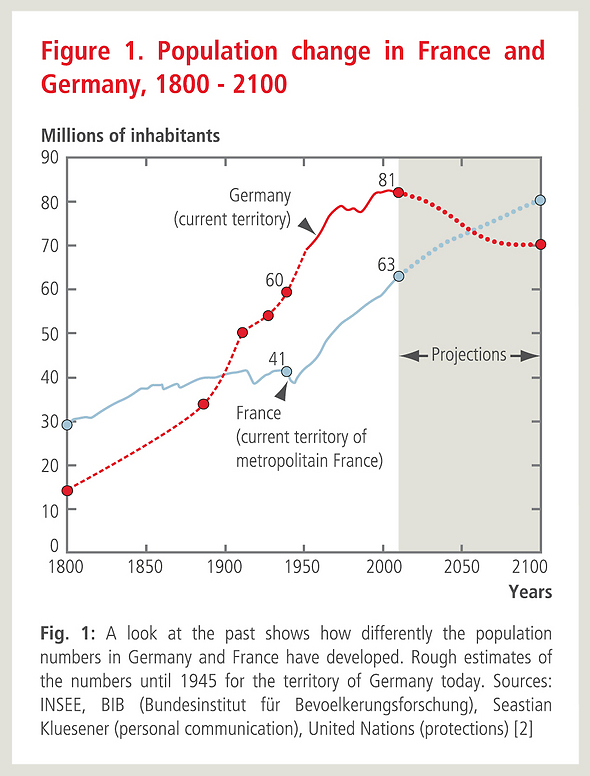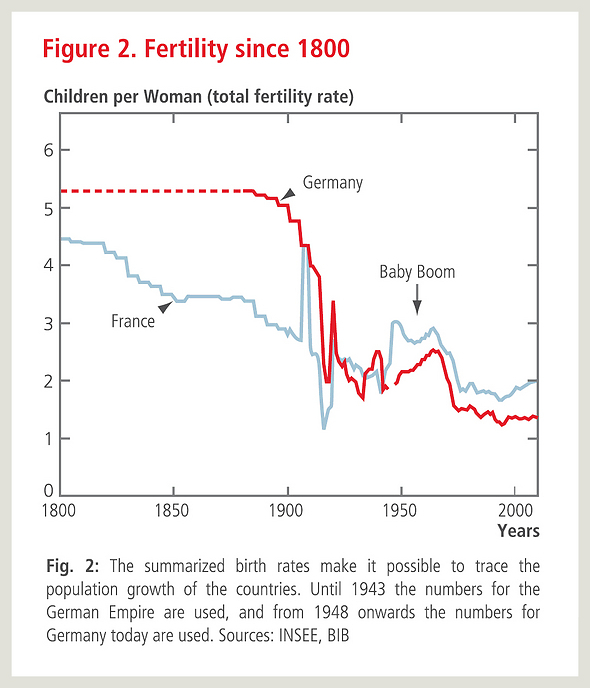January 07, 2013 | News | New Publication
France is growing while Germany is shrinking

In the future, fewer people will live in Germany than in its neighbor to the west © shiningchris / photocase.com
The current situation is clear: around 20 million more people now live in Germany than in France. But while the population in the Federal Republic is expected to decline in the coming years, the number of people living in France continues to grow. In the year 2055, the population of France will overtake that of its neighboring country, according to estimates by the United Nations.
(The following text has also been published in the issue 04/2012 of the demographic quarterly Demografische Forschung aus Erster Hand.)
This would be just another turning point in the eventful population histories of France and Germany, writes Gilles Pison of the French Institute for Demographic Research (INED). Some 200 years ago there was a very similar situation, according to an analysis conducted by the INED in cooperation with the Max Planck Institute for Demographic Research in Rostock. At that time, the situation was reversed: whereas some 30 million people lived in France around 1800, only around half that number, or 15 million people, lived in the territory that corresponds to Germany today, estimates by Sebastian Klüsener of the Max Planck Institute for Demographic Research in Rostock show (see Fig. 1).

The population figures for the period from 1800 to 1945 are difficult to estimate and remain uncertain because Germany at that time consisted of a large number of small states with frequently shifting borders. But with the help of historical population censuses at the district level and geographical information about historical administrative borders in Germany, Sebastian Klüsener has been able to generate approximate values. And the trend for this period is clear: the Germans were the ones who were trying to catch up. Whereas German women continued to have five to six children through the end of the 19th century, the number of children born to French women was increasingly determined by parents. The influence of Enlightenment ideas and the declining role of religion led to increased used of birth control. The birth rate in France thus fell from 5.4 children per woman in the 1750s to around 4.4 children per woman in 1800 and to just 3.4 children per woman by the middle of the 19th century (see Fig. 2).

At that time, the Germans were critical of their aging neighboring country and its woeful lack of children, Gilles Pison notes somewhat ironically. The French, meanwhile, attributed their painful defeat in the Franco-Prussian War of 1870/71 not only to the superiority of the Prussian educational system, but also to the demographic stagnation of their own country. And this trend continued for some time: from 1900 the birth and death rates of the country grew slightly, but these gains were wiped out by World War I. The growth in the French population of one million people from 1900 to 1945 was due to immigration alone. Germany, which had the same number of people as France at the beginning of the century, had 60 million citizens in 1945, and was thus half again as large as its neighbor.
But another turning point came with the arrival of the baby boom in the 1950s, which began earlier and was more pronounced in France. The French population grew one percent a year between 1950 and 1960, while the growth rate in Germany was 0.7 percent. The baby boom ended in the middle of the 1960s in both countries, and the birth rate started to decline. The birth rate had fallen to a value of two children per woman as early as 1970 in Germany, but did not reach this level in France until 1974. Many demographers assumed at that time that the rate would remain at that level in the following years, but by 1990 the rate had fallen to 1.7 children per woman in France and 1.3 children per woman in Germany.
This is partly because women during this period were having their children much later than previous generations. As the number of children born had fallen so suddenly, demographers attempted to explain the low values at the beginning of this period by arguing that there was a “postponement” of births. But this assumption proved to be true only to a certain extent, and to be more applicable to France: France had again reached a birth rate of two children per women by 2000, while in Germany the birth rate was still just 1.4 children per women in 2010.
Thus, Germany is now the country that is seen as an aging nation with too few children. If the UN estimates are correct, the populations of France and Germany will, respectively, expand or contract to reach 70 million by 2055. Whether the population numbers will start to move in similar directions thereafter, or whether these opposing trends will continue, remains to be seen, Gilles Pison writes.